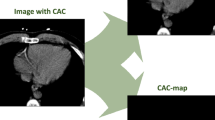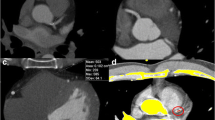Abstract
Purpose
The paper presents new methods for automatic coronary calcium detection, segmentation and scoring in coronary CT angiography (cCTA) studies.
Methods
Calcium detection and segmentation are performed by modeling image intensity profiles of coronary arteries. The scoring algorithm is based on a simulated unenhanced calcium score (CS) CT image, constructed by virtually removing the contrast media from cCTA. The methods are implemented as part of a fully automatic system for CS assessment from cCTA.
Results
The system was tested in two independent clinical trials on 263 studies and demonstrated 0.95/0.91 correlation between the CS computed from cCTA and the standard Agatston score derived from unenhanced CS CT. The mean absolute percent difference (MAPD) of 36/39 % between the two scores lies within the error range of the standard CS CT (15–65 %).
Conclusions
High diagnostic performance, combined with the benefits of the fully automatic solution, suggests that the proposed technique can be used to eliminate the need in a separate CS CT scan as part of the cCTA examination, thus reducing the radiation exposure and simplifying the procedure.
















Similar content being viewed by others
Notes
The described method for calcium segmentation is patent pending.
The described method for calcium scoring is patent pending.
References
Agatston AS, Janowitz WR, Hildner FJ, Zusmer NR, Viamonte M, Detrano R (1990) Quantification of coronary artery calcium using ultrafast computed tomography. J Am Coll Cardiol 15(4):827–832
Otton JM, Lønborg JT, Boshell D, Feneley M, Hayen A, Sammel N, Sesel K, Bester L, McCrohon J (2012) A method for coronary artery calcium scoring using contrast-enhanced computed tomography. J Cardiovasc Comput Tomogr 6(1):37–44
van der Bijl N, Joemai RM, Geleijns J, Bax JJ, Schuijf JD, de Roos A, Kroft LJ (2010) Assessment of Agatston coronary artery calcium score using contrast-enhanced CT coronary angiography. AJR Am J Roentgenol 195(6):1299–1305
Glodny B, Helmel B, Trieb T, Schenk C, Taferner B, Unterholzner V, Strasak A, Petersen J (2009) A method for calcium quantification by means of CT coronary angiography using 64-multidetector CT: very high correlation with Agatston and volume scores. Eur Radiol 19(7):1661–1668
Mühlenbruch G, Wildberger JE, Koos R, Das M, Flohr TG, Niethammer M, Weiss C, Gunther RW, Mahnken AH (2005) Coronary calcium scoring using 16-row multislice computed tomography: nonenhanced versus contrast-enhanced studies in vitro and in vivo. Invest Radiol 40(3):148–154
Hong C, Becker CR, Schoepf UJ, Ohnesorge B, Bruening R, Reiser MF (2002) Coronary artery calcium: absolute quantification in nonenhanced and contrast-enhanced multi-detector row CT studies. Radiology 223(2):474–480
Bischoff B, Kantert C, Meyer T, Hadamitzky M, Martinoff S, Schomig A, Hausleiter J (2012) Cardiovascular risk assessment based on the quantification of coronary calcium in contrast-enhanced coronary computed tomography angiography. Eur Heart J Cardiovasc Imaging 13(6):468–475
Tessmann M, Higuera FV, Fritz D, Scheuering M, Greiner G (2008) Learning-based detection of stenotic lesions in coronary CT data. In: Proceedings of the vision, modeling, and visualization conference. VMV’08, pp 189–198
Mittal S, Zheng Y, Georgescu B, Vega-Higuera F, Zhou SK, Meer P, Comaniciu D (2010) Fast automatic detection of calcified coronary lesions in 3d cardiac CT images. In: Proceedings of the first international conference on Machine learning in medical imaging. MLMI’10. Springer, Berlin, pp 1–9
Moselewski F, Ferencik M, Achenbach S, Abbara S, Cury RC, Booth SL, Jang IK, Brady TJ, Hoffmann U (2006) Threshold-dependent variability of coronary artery calcification measurements—implications for contrast-enhanced multi-detector row-computed tomography. Eur J Radiol 57(3):390–395
Goldenberg R, Eilot D, Begelman G, Walach E, Ben-Ishai E, Peled N (2012) Computer-aided simple triage (CAST) for coronary CT angiography (CCTA). Int J Comput Assist Radiol Surg 7(6):819–827
Begelman G, Goldenberg R, Levanon S, Ohayon S, Walach E (2011) Creating a blood vessel tree from imaging data, US Patent 7983459
Begelman G, Goldenberg R, Levanon S, Ohayon S, Walach E (2011) Method and system for automatic analysis of blood vessel structures to identify calcium or soft plaque pathologies. US Patent 7940977
Kirbas C, Quek F (2004) A review of vessel extraction techniques and algorithms. ACM Comput Surv 36(2):81–121
Lesage D, Angelini ED, Bloch I, Funka-Lea G (2009) A review of 3D vessel lumen segmentation techniques: models, features and extraction schemes. Med Image Anal 13(6):819–845
Kanitsar A, Fleischmann D, Wegenkittl R, Felkel P, Gröller ME (2002) CPR–curved planar reformation. In: IEEE visualization, pp 37–44
Krissian K, Malandain G, Ayache N, Vaillant R, Trousset Y (2000) Model-based detection of tubular structures in 3-D images. Comput Vis Image Underst 80(2):130–171
Worz S, Rohr K (2007) Segmentation and quantification of human vessels using a 3-D cylindrical intensity model. IEEE Trans Image Process 16(8):1994–2004
Coleman TF, Li Y (1996) A reflective Newton method for minimizing a quadratic function subject to bounds on some of the variables. SIAM J Optim 6(4):1040–1058
Tomasi C, Manduchi R (1998) Bilateral filtering for gray and color images. In: Proceedings of the sixth international conference on computer vision. ICCV’98. IEEE Computer Society, Washington, DC, pp 839–846
Rutten A, Išgum I, Prokop M (2008) Coronary calcification: effect of small variation of scan starting position on Agatston, volume, and mass scores. Radiology 246(1):90–98
Schaap M, Metz C, van Walsum T, van der Giessen A, Weustink A, Mollet N, Bauer C, Bogunović H, Castro C, Deng X, Dikici E, O’Donnell T, Frenay M, Friman O, Hernández Hoyos M, Kitslaar P, Krissian K, Kühnel C, Luengo-Oroz M, Orkisz M, Smedby Ö, Styner M, Szymczak A, Tek H, Wang C, Warfield S, Zhang Y, Zambal S, Krestin G, Niessen W (2009) Standardized evaluation methodology and reference database for evaluating coronary artery centerline extraction algorithms. Med Image Anal 13(5):701–714
BIGR (2011) Rotterdam Coronary Artery Algorithm Evaluation Framework. http://coronary.bigr.nl/centerlines/results/results.php Online, Biomedical Imaging Group Rotterdam, Erasmus MC
Rubinshtein R, Eilot D, Halon D, Goldenberg R, Gaspar T, Lewis B, Peled N (2012) Automatic assessment of calcium score from contrast-enhanced 256-row coronary CT angiography. J Am Coll Cardiol 59(13s1):E1185
Ebersberger U, Eilot D, Goldenberg R, Lev A, Spears JR, Rowe GW, Gallagher NY, Halligan WT, Blanke P, Makowski MR, Krazinski AW, Silverman JR, Bamberg F, Leber AW, Hoffmann E, Schoepf UJ (2013) Fully automated derivation of coronary artery calcium scores and cardiovascular risk assessment from contrast medium-enhanced coronary CT angiography studies. Eur Radiol 23(3):650–657
Rumberger JA, Brundage BH, Rader DJ, Kondos G (1999) Electron beam computed tomographic coronary calcium scanning: a review and guidelines for use in asymptomatic persons. Mayo Clin Proc 74(3):243–252
Takahashi N, Bae KT (2003) Quantification of coronary artery calcium with multi-detector row CT: assessing interscan variability with different tube currents pilot study. Radiology 228(1):101–106
Mao S, Bakhsheshi H, Lu B, Liu SC, Oudiz RJ, Budoff MJ (2001) Effect of electrocardiogram triggering on reproducibility of coronary artery calcium scoring. Radiology 220(3):707–711
Stanford W, Thompson BH, Burns TL, Heery SD, Burr MC (2004) Coronary artery calcium quantification at multi-detector row helical CT versus electron-beam CT. Radiology 230(2):397–402
Reinsch N, Mahabadi A, Lehmann N, Möhlenkamp S, Hoefs C, Sievers B, Budde T, Seibel R, Jckel K, Erbel R (2012) Comparison of dual-source and electron-beam CT for the assessment of coronary artery calcium scoring. Br J Radiol 85(1015):e300–e306
Yoon HC, Goldin JG, Greaser LE, Sayre J, Fonarow GC (2000) Interscan variation in coronary artery calcium quantification in a large asymptomatic patient population. AJR Am J Roentgenol 174(3):803–809
Conflict of interest
The authors declare that they have no conflict of interest
Author information
Authors and Affiliations
Corresponding author
Rights and permissions
About this article
Cite this article
Eilot, D., Goldenberg, R. Fully automatic model-based calcium segmentation and scoring in coronary CT angiography. Int J CARS 9, 595–608 (2014). https://doi.org/10.1007/s11548-013-0955-y
Received:
Accepted:
Published:
Issue Date:
DOI: https://doi.org/10.1007/s11548-013-0955-y




